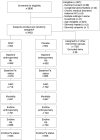Iron status and inherited haemoglobin disorders modify the effects of micronutrient powders on linear growth and morbidity among young Lao children in a double-blind randomised trial
- PMID: 31303184
- PMCID: PMC7672373
- DOI: 10.1017/S0007114519001715
Iron status and inherited haemoglobin disorders modify the effects of micronutrient powders on linear growth and morbidity among young Lao children in a double-blind randomised trial
Abstract
Some studies found that providing micronutrient powder (MNP) causes adverse health outcomes, but modifying factors are unknown. We aimed to investigate whether Fe status and inherited Hb disorders (IHbD) modify the impact of MNP on growth and diarrhoea among young Lao children. In a double-blind controlled trial, 1704 children of age 6-23 months were randomised to daily MNP (with 6 mg Fe plus fourteen micronutrients) or placebo for about 36 weeks. IHbD, and baseline and final Hb, Fe status and anthropometrics were assessed. Caregivers provided weekly morbidity reports. At enrolment, 55·6 % were anaemic; only 39·3 % had no sign of clinically significant IHbD. MNP had no overall impact on growth and longitudinal diarrhoea prevalence. Baseline Hb modified the effect of MNP on length-for-age (LAZ) (P for interaction = 0·082). Among children who were initially non-anaemic, the final mean LAZ in the MNP group was slightly lower (-1·93 (95 % CI -1·88, -1·97)) v. placebo (-1·88 (95 % CI -1·83, -1·92)), and the opposite occurred among initially anaemic children (final mean LAZ -1·90 (95 % CI -1·86, -1·94) in MNP v. -1·92 (95 % CI -1·88, -1·96) in placebo). IHbD modified the effect on diarrhoea prevalence (P = 0·095). Among children with IHbD, the MNP group had higher diarrhoea prevalence (1·37 (95 % CI 1·17, 1·59) v. 1·21 (95 % CI 1·04, 1·41)), while it was lower among children without IHbD who received MNP (1·15 (95 % CI 0·95, 1·39) v. 1·37 (95 % CI 1·13, 1·64)). In conclusion, there was a small adverse effect of MNP on growth among non-anaemic children and on diarrhoea prevalence among children with IHbD.
Trial registration: ClinicalTrials.gov NCT02428647.
Keywords: Anaemia; Diarrhoea; Growth; Inherited Hb disorder; Iron status; Micronutrient powder; Young children.
Figures




References
-
- Black RE, Victora CG, Walker SP, et al. (2013) Maternal and child undernutrition and overweight in low-income and middle-income countries. Lancet 382, 427–451. - PubMed
-
- World Health Organization (2016) WHO Guideline: Multiple Micronutrients Powders for Point-of-use Fortification of Foods Consumed by Children 6-23 Months of Age and Children Aged 2-12 Years. Geneva, Switzerland: World Health Organization.
-
- Pasricha SR & Drakesmith H (2016) Iron deficiency anemia: problems in diagnosis and prevention at the population level. Hematol Oncol Clin North Am 30, 309–325. - PubMed

